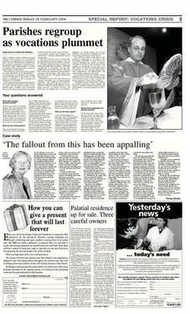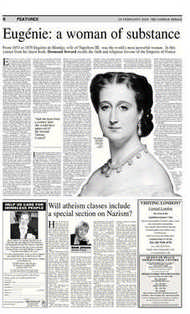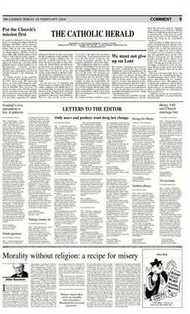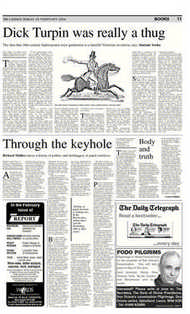Page 11, 20th February 2004
Page 11

Report an error
Noticed an error on this page?If you've noticed an error in this article please click here to report it.
Tags
Share
Related articles
Tvand Radio
Jesse James
Darwin To Dna
Parents' Choice A Selection Of Books For Children T Here Are
Tale Of Mechanised Slavery
Boxing Education Lic Herai.d. Dated Friday. October To...
Dick Turpin was really a thug
The idea that 18th-century highwaymen were gentlemen is a fanciful Victorian invention, says Alastair Sooke
Dick Turpin: The Myth of the English Highwayman by James Sharpe, Profile Books £15.99
The question of evil has always been a knotty problem, tangling theologians, philosophers and artists alike in Gordian complexities and subtle sophistries of thought. It seems paradoxical that evil can be at once so bad and so fiendishly tempting.
The figure of the highwayman epitomises this conundrum, as James Sharpe’s comprehensive study of crime’s most “dashing” perpetrators reveals. Posterity has gilded highwaymen such as Dick Turpin with mystique and romance, despite the fact that most were violent thugs.
A Victorian painting that demonstrates how high culture has romanticised the highwayman illustrates Sharpe’s discussion. The robbers in William Powell Frith’s “Claude Duval”, completed in 1860, are far too refined to be ruffians. Their swag bags are woven from silk, not sackcloth, while their black masks are the latest in criminal chic. These felons kill ladies rather than people: Claude Duval, a highwayman once more famous than Turpin himself, commands the lady’s attention with an easy éclat. The thigh boots, perhaps fashioned from soft doeskin, the crimson frock coat with its gilt trimmings, the lace cuffs and collar: the haute couture trappings all signify Duval’s raffish nature.
Yet the highwayman’s glamour, according to Sharpe, is so much sexing up. “The veneer of gentility, gallantry, and politeness, if it existed at all, was a thin one,” he writes. The historical substance behind the highwayman’s style was far more banal and brutal, and this is especially true of the archangel of this genteel criminal class and the most prominent highwayman in Sharpe’s work: Dick Turpin.
As he presents us with the facts of Turpin’s life and debunks the fairy tales that surround him, Sharpe dissects his subject like those 18th-century physicians who anatomised the cadavers of executed criminals. Turpin’s ability to spin thuggery into a folk hero’s tale might make Alastair Campbell jealous, but Sharpe makes a coffin of the highwayman’s hitherto successful self-image, into which he knocks nail after nail of historical evidence. In a sense, he should be applauded for undertaking a difficult task, since nobody likes a party-pooper or a pedant.
Sharpe is history’s Lord Hutton: his report on Dick Turpin is meticulous, clamping down on any journalistic “image” and favouring, with some considerable justice, the “reality” of the facts.
The real Dick Turpin was finally executed for horse theft, an ignominious crime devoid of daredevilry and dash. The new frock coat that he bought for his appearance at York’s gallows in April 1739 was as close as the historical Richard Turpin came to his swashbuckling, silk-clad image; Sharpe reveals how Turpin was heavily pockmarked, of average height and as unpleasant and violent a criminal “as any who commit crimes today”. He was also forgotten a half-century after his death.
We know little about Turpin’s early history. He was baptised in Essex in 1705 and most likely followed his father into the butcher’s trade before he began to fraternise with a local gang of deer-stealers.
Together, they graduated to harder crimes, undertaking a campaign of ultraviolence that wouldn’t look out of place in Stanley Kubrick’s Clockwork Orange. Turpin turned to highway robbery in 1735, when the other gang members were rounded up, evading the authorities until a certain Thomas Morris discovered his
hideout in a cave in Epping Forest. Turpin shot Morris with his carbine as he approached, killing him instantly and “finally adding murder to the tally of his crimes”. With the south of England now too hot to hold him, Turpin fled to Yorkshire, where he was eventually arrested for horse theft under an assumed name.
As Sharpe persuasively argues, these events end any desire that the modern reader might feel to romanticise the historical Richard Turpin. He delights in proving that no contemporary evidence corroborates the two main components of Turpin’s later legend: that he owned a horse named Black Bess, and that he rode to York in record time. Sharpe’s narrative is a continuous bout of mythbaiting, as he stomps over every outburst of fancy with the historian’s heavy boots of fact.
So if the British public has been sold a lie about Turpin, who is responsible for his romantic image? Sharpe points his finger at the Victorian novelist William Harrison Ainsworth, some of whose works outsold Dickens in their day. Rookwood, his best-selling novel published in 1834, featured Turpin as one of those “chivalrous knights of the road” comparable to “our great Nelson”. “It is as necessary for a man to be a gentleman before he can turn highwayman, as it is for a doctor to have his diploma,” says one character in the novel, something with which Sharpe violently disagrees.
But the popularity of Ainsworth’s Turpin signalled how marketable a criminal he could be. Sharpe’s most subtle analysis comes in describing how highwaymen became commodities, marketing everything from literary novels to penny dreadfuls, from the Carry On franchise to today’s heritage industry. He even unearths Turpin-endorsed sausages and “Turpin pornographia”.
Yet Sharpe can be short-sighted and, in some instances, disingenuous. While he proclaims himself an iconoclast of criminal heroes, he has colluded with Turpin just by writing about him. He begrudges the highwayman his long-lasting fame, despite the fact that Turpin provides him with a juicy subject. Sharpe may be Professor of History at York University, but this is an unashamedly populist work, without footnotes, that will sell copies and receive wide coverage precisely because it exploits Dick Turpin’s myth. Sharpe resembles all the authors writing about criminals in pamphlets and chapbooks whom he criticises for pandering to schlock sensationalism beneath a didactic veneer.
Sharpe has written a work of pulp history, and very entertaining it is too. But of greater interest would have been a more complex discussion of why we choose to make heroes of our antiheroes. Sharpe dismisses Turpin’s “potent mythology” as fanciful frippery, lamenting the fact that “the shadowland of myth and legend [has] eclipsed historical reality so powerfully”. But he misses the fundamental point that the Turpin of this twilight realm is as real, in some senses, as the Richard Turpin who was born in Essex. How did an outlaw become an outré icon? Surely the motivation behind this cultural apotheosis of villains is the most complex question of all.
blog comments powered by Disqus















